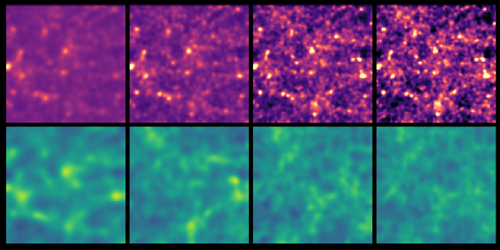Machine Learning Pins Down Cosmological Parameters
The history of the Universe is governed by a handful of cosmological parameters, such as the present-day matter density and amplitude of density fluctuations ( Ωm and 𝜎8, respectively). Astronomers have measured these parameters by observing the large-scale structure of the Universe, but the measurement precision has been limited by several parameter degeneracies. For example, an increase in Ωm can counteract a decrease in 𝜎8 and vice versa. Now Tomasz Kacprzak and Janis Fluri at the Swiss Federal Institute of Technology (ETH), Zurich, have found a way to break such degeneracies, strengthening the constraints on these parameters [1].
The Universe’s large-scale structure is typically probed by studying galaxy clustering or via a statistical gravitational-lensing signature called weak gravitational lensing (see Viewpoint: Weak Lensing Becomes a High-Precision Survey Science). Each of these techniques has associated parameter degeneracies: for galaxy clustering, Ωm and 𝜎8 can take on any number of values depending on the assumed galaxy bias, which quantifies how well visible matter traces invisible dark matter; for weak lensing, Ωm and 𝜎8 are similarly degenerate with the intrinsic alignment amplitude, which measures the extent to which galaxies are aligned with one another.
Kacprzak and Fluri found that these degeneracies could be lifted by using deep learning—a type of machine learning inspired by the human brain—to perform a collective analysis of galaxy-clustering and weak-lensing data. The researchers show that, for future large-scale-structure surveys, this approach could tighten constraints on the galaxy bias and on the intrinsic alignment amplitude by factors of about 1.5 and 8, respectively. In turn, the method could substantially strengthen constraints on both Ωm and 𝜎8. However, the team says that an improved data analysis and understanding of survey systematic effects is needed before the technique can be used in practice.
–Ryan Wilkinson
Ryan Wilkinson is a Corresponding Editor for Physics Magazine based in Durham, UK.
References
- T. Kacprzak and J. Fluri, “DeepLSS: Breaking parameter degeneracies in large-scale structure with deep-learning analysis of combined probes,” Phys. Rev. X 12, 031029 (2022).




